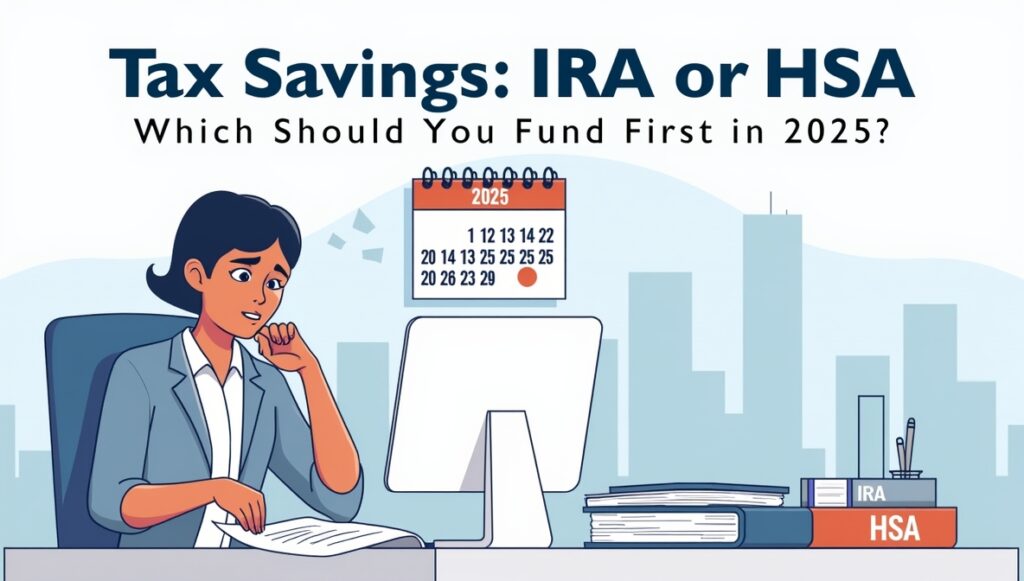
Choosing between an IRA and an HSA can feel confusing — both offer unique advantages for tax savings. In 2025, as contribution limits and healthcare costs rise, knowing whether to fund your IRA or HSA first could make a significant difference in your financial future. This guide breaks down the essentials so you can make informed decisions and maximize your IRA vs HSA tax savings.
Why IRA vs HSA Tax Savings Matter in 2025
In 2025, U.S. taxpayers face evolving retirement and healthcare expenses. Strategic planning for tax savings through IRAs and HSAs can help reduce taxable income and secure future health costs.
Key 2025 updates include:
- HSA contribution limits: $4,300 for individuals, $8,550 for families (+$1,000 catch-up at 55+) (Fidelity).
- IRA contribution limits: $7,000 (plus $1,000 catch-up at 50+).
- Medical cost inflation: Expected to rise by 6–7%, making HSAs more valuable than ever.
💡 Related reading: Roth vs Traditional IRA: What’s Best for You?
Understanding the Basics of IRAs and HSAs
Traditional and Roth IRAs
An Individual Retirement Account (IRA) helps you save for retirement while reducing taxable income.
- Traditional IRA: Pre-tax contributions; withdrawals taxed later.
- Roth IRA: After-tax contributions; withdrawals are tax-free.
- Contribution limits: $7,000 ($8,000 if age 50+).
Health Savings Accounts (HSAs)
An HSA is available to those with high-deductible health plans (HDHPs). It’s one of the most powerful tools for tax savings because it offers:
- Tax-deductible contributions
- Tax-free growth
- Tax-free withdrawals for medical expenses
Plus, HSAs roll over year to year — no “use it or lose it” rule applies.
🖼️ Image alt text suggestion: “IRA vs HSA tax savings comparison chart”
💡 Related reading: Managing Health Costs in Retirement
IRA vs HSA Tax Savings: Key Differences
| Feature | IRA | HSA |
|---|---|---|
| Eligibility | Anyone with earned income (subject to limits) | Only with HDHP coverage |
| Contribution Limit (2025) | $7,000 / $8,000 | $4,300 / $8,550 |
| Withdrawals | Taxed (Traditional) or tax-free (Roth) | Tax-free for qualified medical costs |
| Penalties | 10% before 59½ | 20% before 65 for non-medical |
| RMDs (Required Minimum Distributions) | Yes, for Traditional IRAs | None |
| Triple Tax Advantage | ❌ | ✅ |
Both provide tax savings, but the HSA offers unmatched flexibility for future medical costs.
When to Prioritize Your HSA for Tax Savings
Many financial planners recommend funding your HSA before your IRA — if you’re eligible. Here’s why:
- Immediate tax deduction: Every dollar reduces taxable income.
- Triple tax advantage: Contributions, growth, and qualified withdrawals are all tax-free.
- No RMDs: Funds can grow indefinitely.
- Dual purpose: After age 65, HSA funds can be used for non-medical expenses (taxed like an IRA).
🖼️ Image alt text suggestion: “HSA contribution benefits and tax savings in 2025”
💡 Related reading: How to Optimize Your 401(k) Contributions
When to Fund an IRA First
Situations where an IRA might come first include:
- You don’t qualify for an HSA (no HDHP).
- You expect lower healthcare costs but higher retirement needs.
- You prefer Roth flexibility — tax-free withdrawals anytime after 59½.
- You’ve already maxed out your employer’s HSA match (if offered).
The IRA gives long-term growth and flexibility, while still providing meaningful tax savings if used strategically.
Recommended Funding Order for 2025
To maximize IRA vs HSA tax savings, consider this order:
- Max out your employer 401(k) match (free money!)
- Fund your HSA up to the 2025 limit.
- Contribute to an IRA (Traditional or Roth).
- Return to your 401(k) or other investment accounts.
This order captures all available tax savings opportunities while maintaining flexibility for healthcare and retirement.
🖼️ Image alt text suggestion: “IRA vs HSA tax savings strategy infographic 2025”
Case Example: Optimal Savings Strategy
Scenario:
- 35-year-old single filer
- HDHP coverage and eligible for HSA
- Employer contributes $1,000 annually to HSA
Optimal plan:
- Capture 401(k) match (up to 4%).
- Max out HSA: $4,300 in 2025.
- Contribute to Roth IRA for long-term growth.
- Invest additional savings into taxable accounts.
This approach creates layered tax savings while covering both health and retirement goals.
Boosting Your IRA vs HSA Tax Savings in 2025
To squeeze every bit of tax savings:
- Invest HSA funds instead of leaving them in cash.
- Keep receipts for future reimbursement.
- Reassess annually as income and tax laws change.
- Consult a tax professional for personalized strategy.
- Use both accounts strategically — HSA for health expenses, IRA for retirement.
External Resource: IRS Publication 969 – Health Savings Accounts and Other Tax-Favored Plans
Final Thoughts: Balancing IRA and HSA for Maximum Tax Savings
In 2025, both the IRA and HSA remain powerful tools for tax savings.
If eligible, max out your HSA first after capturing any employer match — then turn to your IRA. The combination of healthcare protection and retirement growth ensures flexibility and security for your financial future.
Remember: The best tax strategy is the one you can sustain consistently.


